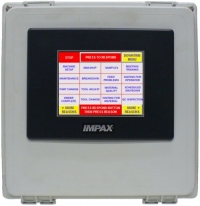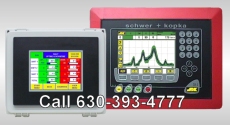|
|
|
Return On Investment: IMPAX TSS Efficiency Monitor
By: Process Technologies Group, Inc.
Topics: Return on Investment, Efficiency, Analysis, Profitability, IMPAX TSS
Examples of how IMPAX TSS efficiency and downtime monitors can pay for themselves

IMPAX TSS Monitor
|
An IMPAX TSS-6 Efficiency Monitor is an excellent investment in your production process. Here are a few ways that a TSS monitor can pay for itself by helping solve problems and improve your processes.
Efficiency Increases:
- Order counter eliminates job overruns.
- Downtime data identifies previously-unreported lost time when machines could be run (long lunches or breaks, late shift starts).
- Additional counters let maintenance operations be scheduled every X parts, instead of every X hours, resulting in more accurate maintenance.
- Efficiency data identifies feed problems and speed problems, resulting in increased productivity.
- Displayed production data motivates operators to work more efficiently, and promotes competition among shifts.
- Displayed "minutes remaining for current job" allows operators to prepare upcoming job tooling in advance, reducing downtime between jobs.
Problem Detection:
- Real production and uptime/downtime data is tracked, instead of hand-recorded estimates, resulting in a more accurate understanding of the production process.
- Real-time data display allows for immediate problem identification and correction, so problems can be addressed quickly.
- Real-time OEE (Overall Equipment Effectiveness) display identifies and diagnoses production problems as they occur.
- Downtime reason data identifies common and time-consuming problems, and provides cost-justifications for upgrades and other corrective actions.
- Tooling data identifies good and bad tools, and provides cost-justifications for tooling repairs and redesigns.
- Operator response time data identifies insufficient manpower situations, where machines may be sitting idle.
Trend Analyses:
- Software reporting can identify problem trends by machine, part number, operator, or shift; for example:
- Identify profitable/unprofitable parts
- Identify parts that run better on some machines than on others
- Identify machines that have specific problems more frequently
- Identify operators with problem areas, who may need more training
"Non-value" Activity Reduction:
- True production is counted, eliminating the need for weighing or hand-counting.
- Uptime/Downtime is automatically monitored, eliminating the need for operator self-reporting.
- Data is collected across the network, eliminating the need for (error-prone) data entry, and reducing data-entry staffing requirements.
- Two-way messaging system reduces number of trips out to the shop floor, and eliminates need for operator to leave the machine unattended.
- Built-in reporting utilities eliminate the need for generating reports by hand.
- Shop overview software provides the manager with real-time information on the whole shop, which eliminates the need for frequent time-consuming floor trips.
Conclusion
These are just a few of the ways that an IMPAX TSS-6 Efficiency Monitor can help your production process. Our customers' TSS monitors have paid for themselves many times over, by saving them time and money.
The biggest benefit of the IMPAX TSS system is information: true and timely process information is the key to increased productivity and profit. And IMPAX TSS monitors provide unparalleled access to machine process information.
Company and Product Profile
IMPAX TSS Monitors combine PLC technology and user-friendly software in a powerful machine efficiency and downtime tracking system. TSS monitors work as stand-alone units and are also networkable, forming a powerful production monitoring and downtime analysis system.
More information: IMPAX TSS Monitors, TSS-NET Software
Process Technologies Group, Inc. (PTG) designs and manufactures process monitors, efficiency monitors, sensors, and data collection software for all production environments.
More information: www.impaxptg.com
Request More Information, or a Quote
Back to Articles
|
|

